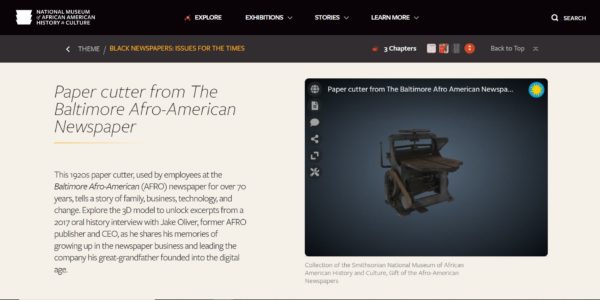Civic tech isn’t just about making the trains run on time through machine learning or AI. It can also involve creative ways for taxpayers to visit the museums they fund any time they want.
The Smithsonian’s National Museum of African American History and Culture is always one click away thanks to The Searchable Museum — a platform created in collaboration with Baltimore-based digital services firm Fearless. Last year, the firm made the museum’s “Slavery and Freedom” exhibit into a virtual experience. This year, the civic tech firm released its second online exhibition, “Making a Way Out of No Way,” which illustrates perseverance, resourcefulness and resilience in African American history from the late 1800s through the 20th century.
At least one Fearless employee sees The Searchable Museum as a pathway for historians to tell important stories in ways that will reach more people than a traditional literary avenue might.
“We are enabling the historians to enter into this new kind of market,” Kelsey Johnston, content strategist at Fearless, told Technical.ly. “If they had their way, they would write a novel. We’re encouraging them to use a variety of different components and visual elements, video, whatever they have in the collection or whatever we can get produced for this specific site in order to make it a little bit more compelling to a digital user.”
The digital experience layers on such multimedia elements as an oral history of the AFRO American Newspapers from John Jacob Oliver, the media company’s former CEO and great-grandson of founder John J. Murphy, over a 3D digital scan of a paper cutter that the publisher used for much of the 20th century.
All of this was created through the Agile software development framework, where features and content are delivered in two- to four-week chunks.
“Rather than waiting until we have absolutely everything — and there’s no room to be flexible, no room to add on — we do it in this way so that it can scale,” Fearless Scrum Master Michelle Adekolu said about Agile development.
To create features on the site, like the virtual map plotting historically Black colleges and universities across the U.S., the firm used frontend tools like Gatsby and the content management system Craft. Fearless also tracks traffic to the different sections of the virtual exhibit using Algolia, as well as Google Analytics to gauge the product’s effectiveness.
Fearless didn’t want a lack of access to VR technology or a laptop to be a barrier to entry. It, therefore, made the site friendly for those accessing it via mobile phones and non-VR-dependent platforms. The company feels that the history and information are too important to gatekeep or squirrel away behind the need for expensive technology. Accessibility in all forms was important.
“Making sure that people with all kinds of abilities can access and enjoy this site,” Johnston said. “You don’t need a fancy headset in order to experience these artifacts. Maybe one day when the metaverse is more accessible to everyone, it’ll be a searchable museum within the metaverse. But for now, I think we’re really happy staying in this space where everyone is still playing.”
Donte Kirby is a 2020-2022 corps member for Report for America, an initiative of The Groundtruth Project that pairs young journalists with local newsrooms. This position is supported by the Robert W. Deutsch Foundation.Before you go...
Please consider supporting Technical.ly to keep our independent journalism strong. Unlike most business-focused media outlets, we don’t have a paywall. Instead, we count on your personal and organizational support.
Join our growing Slack community
Join 5,000 tech professionals and entrepreneurs in our community Slack today!





